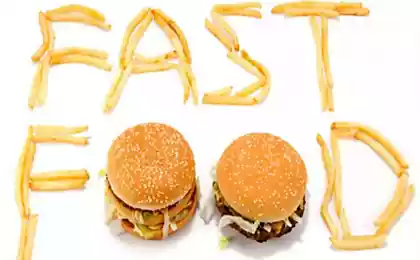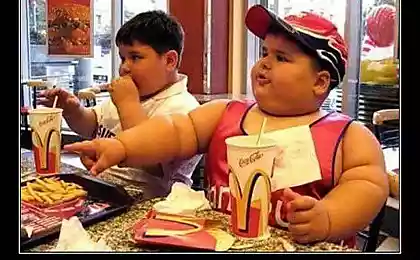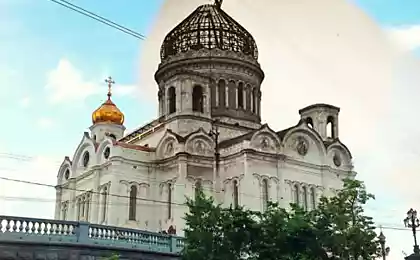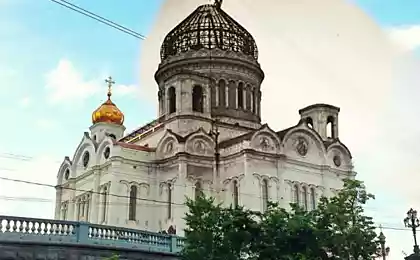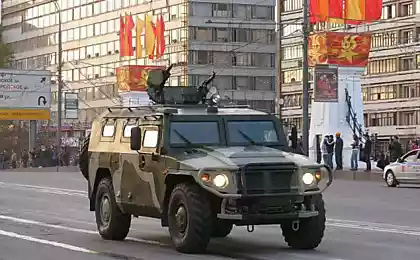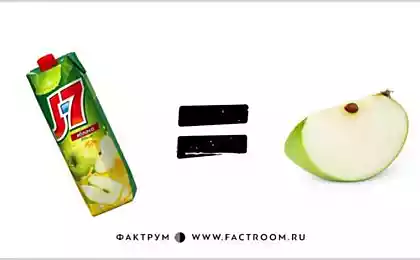2572
As in 1937, there was almost a Soviet "McDonald's" (10 photos)
Warm summer evening in 1936, People's Commissar of food industry, Anastas Mikoyan was going on vacation. Ahead loomed tempting month in Sochi, together with his beloved wife Ashkhen Lazarevna and five sons. Could only say goodbye to Joseph Vissarionovich, and can serve on the south. When Mikoyan started a speech on vacation in Sochi, "leader of the people," he lit up, suddenly said to him: "What do you, my friend, Anastas Ivanovich do in Sochi? Do not go if you a couple of months in America? And the rest you will be there, and to study the experience of the American food industry ».
Mikoyan, though, and was informal title of "People's Commissar Stalin loved" yet dared to object to the leader, saying that relatives do not understand, especially his wife.
"And you take it with you - smiled leader - and your kids let us have a rest in Crimea. For the general, so to speak peace. We will give you as much money as you need to immediately buy equipment that will appeal to all powers to enter into contracts. Well, accompanying course. Ten people, no more ... »

I can not vouch for the accuracy of the dialogue, but the gist of it was just that: Mikoyan and his wife willed leader was sent to the North American United States to watch there something suitable for our country. And a week later, a small delegation went to America. First train to Berlin, then to Paris, and then from Havre steamer "Normandy" straight to New York ...
About tasty and healthy food
After three years after that trip to the USSR was published "culinary bible" - "The Book of Tasty and Healthy Food", which appeared with the direct participation Anastas Mikoyan and literally imbued with reverence for the American experience and the desire to move it to the Soviet soil.
On this occasion, he recalled the words of the People's Commissar "best friend of Soviet food industry»:
"It is no coincidence, Comrade Stalin said that we need a connection Russian revolutionary sweep with American efficiency." And in the book constantly encountered quotes like: "In outlining the breakfast menu, it is useful to recall the good American custom: to submit to an early breakfast variety of fruit." Or: "In America, the production of fillets received extremely broad development. In recent years, production of fillets and organized in the USSR ».
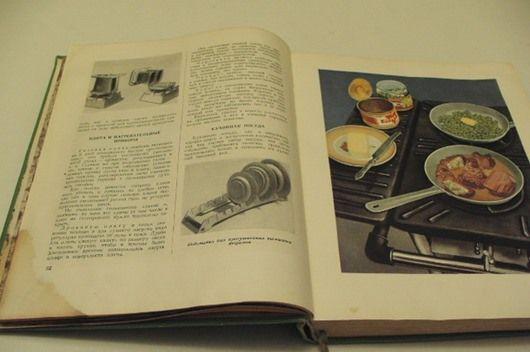
However, following post-war edition of "The Book of Tasty and Healthy Food" came out several "castrated". In 1952 he lost all references to America and American food, in 1954 about Stalin, in 1974 about Mikoyan. As if it was not the famous American travel "loved the people's commissar," which brought and introduced into the life of the Soviet people these types of products and technologies that they after a while began to consider the age-old Soviet, despite the fact that the original packages and machines was written «Made in USA» ...
Soviet ice cream was not. And no ...
In the first paragraph of your stay in the United States - New York delegation headed by Mikoyan tasted and selected as a promising eight varieties of ice cream. Memorable many of our readers with the experience creamy ice cream and milk, creme brulee, choc, vanilla, popsicles were recommended for production in the USSR. The first samples of it went on sale Nov. 4, 1937.
Mikoyan recalled:
"Great benefit from our familiarity with the production of ice cream. We have become a tradition with the age-old times, artisanal ice cream manufacturer, manual way. The objective was to develop machine production and make ice cream cheap and affordable. Demand for it we ubiquitous, it is now happy to eat at home and on the streets, cinemas and theaters, summer and winter. As a result, we had brought from the United States all the technology of industrial production of ice cream.
Soon the Moscow refrigerator number 8 was completed construction of the first ice cream factories, equipment for which it was decided to purchase in the United States. And indeed, on equipment purchased in the United States, our factory, since 1938, began to produce ice cream more than doubled compared to the previously planned ".

Quality controlled cruelly treats, and entered March 12, 1941 GOST 117-41 "ice cream sundae, ice cream, fruit and berry, aromatic" was one of the toughest standards in the world.
The basis of the quality of all natural ingredients, exclusively milk fat and no preservatives. Almost a quarter of a century, given the interest of the powerful Mikoyan to this product, any "mischief" to the recipe were excluded.
It is currently held Anastas Ivanovich American quality ice cream as long as he kept an impact on the political Olympus. Can be arbitrarily assess and interpret events, but after the fall of Khrushchev and Brezhnev came to power, who did not like Mikoyan, it took only two years, and "Mikoyan" ice cream was gradually sinking into oblivion.
In 1966, the establishment of a guest at the ice cream given region. Somewhere (especially in Moscow and Leningrad) quality is maintained, in other places in order to reduce the cost of the finished product, it became "bodyazhit." And in 1986, the system finally collapsed: ice cream began to produce "technical specifications". This coincided with the emergence of a multitude of chemical flavorings, stabilizers and other additives, which gave ice cream "identical to natural" taste. The same one that we are able to fully enjoy if buy our modern ice cream. And then I want to remember the good word and Mikoyan, and his American trip ...
Something about mayonnaise "Provence»
My mother lived in a house located just a few hundred meters from the "Smolensk" deli (by the way, the term "deli" also came up with Mikoyan). She told me how Muscovites in 1937 (she was 11) were taught to use mayonnaise.
The new product will be on sale only, for some reason, no one was interested. Advertising on TV and radio did not exist, this sauce on the posters began to advertise only a year later. And in the halls of "Smolensk" were girls with trays. They were pieces of bread smeared with mayonnaise, which offered to everyone "on trial." People tried and wondered unconventional taste.

Old regime grandparents nostalgic pre-revolutionary homemade mayonnaise, and the new Soviet citizens gradually began to take an interest in yellowish-white product in jars with screw cap.
September 11, 1936 in Chicago at the agricultural exhibition Mikoyan acquainted with the technology of production of mayonnaise, which later received the name "Mayonnaise mayonnaise." And then visited the mayonnaise factory and entered into an agreement for the production of mayonnaise on US technology in the Soviet Union.
This product of the Soviet-American cooperation and survived World War II, and the fight against cosmopolitanism (then just stopped mentioning its origin), and the death of Stalin, Khrushchev and Brezhnev ...
Grandson Vladimir Anastas Mikoyan recalled: "I had one case with the director of the Moscow fat plant, now deceased, known for our expert in the field of oil and fat Leonid Pavlovich Aznauryanom ... I tried to persuade him to modify the recipe mayonnaise" Provence "and use some new ingredients that allow reduce the cost of the product. On what he told me: "This recipe for mayonnaise approved, signed by your grandfather. What else can be questions for me? I'll save it and preserve so that people know that now I have the same classic mayonnaise ".
But still real, "Mikoyan" "Mayonnaise Provencal" stayed on the shelves of our country nearly half a century and has been an integral part of the Soviet feast from the holidays and birthdays to wake and wires in the army ...
Stalin could not tolerate dry champagne
An interesting thing happened with the start of mass production of the drink, which was called "Soviet champagne". In the summer of 1936 before traveling to America Anastas Mikoyan said:
- Comrade Stalin said that the Stakhanovite now earn a lot of money; earn a lot of engineers and other workers. And if you want to buy champagne if they can get it? Champagne - a sign of material well-being, a sign of prosperity!
In 1936, with the "flow" Mikoyan was accepted by the Central Committee of the CPC and the Soviet Union, according to which it was planned to release "Soviet champagne" in large numbers. Naturally, the traditional way to produce 12 million bottles for 5 years was not possible, so we decided to use a method that in 1907 invented Eugene Sharma. Now we all know that most of the "Champagne" and really just "sparkling" wines are produced in huge tanks, and not kept in bottles.
A trip to the United States with a visit to the factory "fizzy champagne" in Oakland Mikoyan finally convinced that a relatively cheap and pleasant to the taste of the drink should be done with this technology. Manage the process was entrusted known even in Tsarist Russia winemaker Anton Frolov Bagreeva, who adapted the Italian-American approach to our conditions. The first set of equipment (for Rostov factory) was purchased from French company "Shosep».
Mass production of "Soviet champagne" began in 1937. Stalin, as recalled Mikoyan, not like dry champagne and "Brut". But the sweet and semi-sweet he drank with pleasure. Production of "sour" little has been collapsed, but a "favorite Commissar Stalin" convinced the leader that the export of these drinks must be done.
As a result, the drink has become a truly "popular", and no New Year's Eve, no wedding could not do without the "Soviet champagne". The other, the present, in our country there was no ...
Bread - a head!
It would seem that some could there America to the Soviet Union - the heir to the great grain-producing Russia for the production of the main staple food - bread? It turns out that she could, how! Mikoyan wrote on this subject:
"I must say that at that time in our country's industrial bakery provides less than 40% of the urban population. The peasantry, which constituted then the majority of our population, produce all the bread alone, at the expense of home-baked. Therefore, the translation of the Soviet consumer's bread factory is equivalent to a revolution in the field of life.
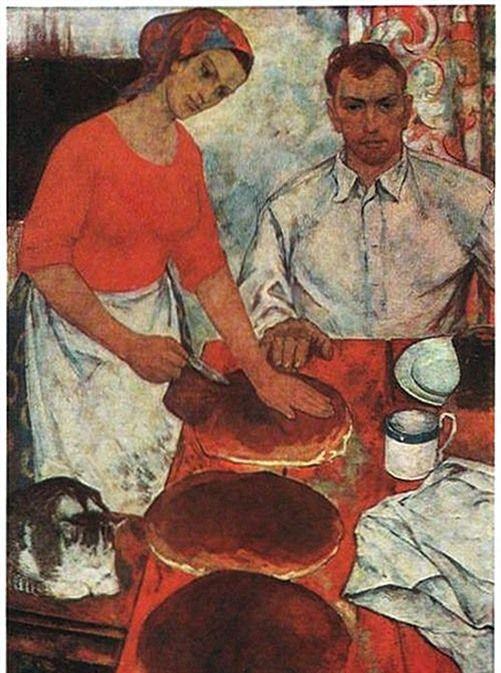
In the United States in those days everything was good factories mechanized: the bread does not touch the hand of man. All this depended on technology, and we believe that there is no need to say, again "reinvent the wheel", since he had already invented by others. Therefore, a lot has been taken by us from the Americans.
For example, we brought from America mechanized production of rolls, which were made before hand and were called "French." A new type of loaves we call "urban».
In September, 1936, in Chicago Mikoyan acquainted with the industrial production of bread and purchased equipment for bakeries.
Turn to our readers, especially those who remember our bakery products to mid-80s. Is not it, "urban" buns price of 7 cents per share were wonderful?
But someone has to remember that even these relatively "mass" of American origin rolls freely sold only in large cities. And in the outback was usually two main types of bread: black and white (though it was rather gray). And those are the types of bread made by true Soviet technology, though sometimes preserved on the American equipment ...
And domestic refrigerators too ...
I think Anastas Mikoyan more cunning when he wrote in his memoirs the following lines: "Being in America, I was surprised to see at" General Electric Company, "a special workshop for the production of domestic refrigerators. This workshop annually marketed more than 100 thousand of these refrigerators, enjoyed great success with the public.

After returning from the United States, in an interview with Stalin, I raised the question of how to proceed, and we have to mass production of domestic refrigerators, with organizing production at several of our largest engineering plants (which was subsequently done).
But then Stalin did not agree with me, referring to the fact that in large parts of the country winters are long and therefore unnecessarily in cold there, and in the summer months, our people are used to keep products in glaciers and cellars and also our heavy engineering plants are very busy including defense orders. The final argument was, of course, crucial ".
Of all people, as a "favorite Commissar" was not uninformed and naive person. And he, being familiar with Sergei Kirov, must have known that he was still in 1933 wrote itself from America household refrigerator that same company "General Electric", which Mikoyan visited the United States.

Some historians, incidentally, argue that such a second fridge (but it was worth in the early 30's about two car "Ford") was near the Mikoyan. A "Kirov" unit that has been preserved until now, a few years ago was on display at the museum Kirov in St. Petersburg.
The first samples of Soviet domestic refrigerators are made in the image of the US, appeared in 1939, but truly began mass production of their ten plus years.
As we have in 1937 appeared almost "McDonald's»
Walking through the summer of 1936 in New York, Mikoyan drew attention to the remarkable product of local caterers, sell on the streets:
"Drew our attention to the mass machine production standard burgers that are hot sold with a bun - the so-called" Hamburger "- on the street in kiosks ...
Chicken roasted with one hand and then flips to the other party - and within a few minutes, it is ready. This same seller are buns. He cuts a bun, puts into hamburger, add tomato, slice pickles or mustard, and here's a hot sandwich. For the busy person very comfortable ".
Does not it remind you, dear readers, this technology is the one that is used today in Moscow, and in all the other "McDonald's"? By the way, Impressed by what he saw, Mikoyan, with its inherent scale, immediately ordered 25 machines in the United States for the production of burgers, which are able to produce two million "Soviet hamburgers" in the day. And then bought braziers for heating samples of these products and a plant for the production of biscuits.
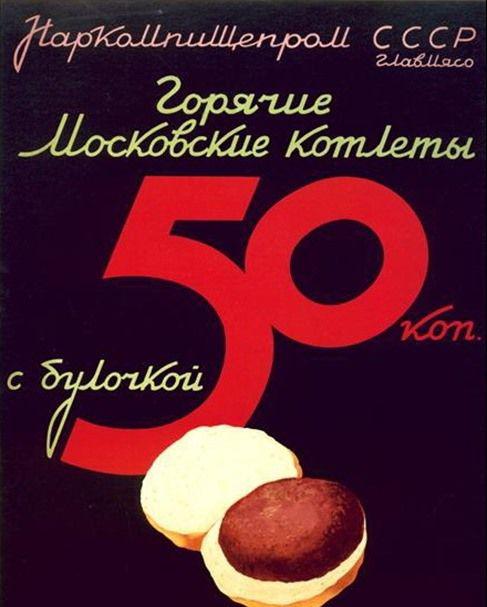
But in the "McDonald's" food and drink taken yet. Anastas Ivanovich and has attended this question:
"The great interest in our group and led to the production of soft drinks. We then let themselves fairly large number of fruit with water, but ensure that they are of equivalent quality to all enterprises still could not.
In America, the mass production of standard quality fruit with water was provided by the organization of production - namely, the elaboration of a few plants relevant extracts. These extracts were then transported to the country. Extract composition in each is the same firm and as a rule, very high quality. We have studied the process of production of Coca-Cola, but resource constraints we had not been able to establish themselves in a similar case ".

I will say more: the release of hamburgers in the USSR began in 1937, but on the "Coca-Cola" money is not enough - did not want the Americans to sell prescription only offer delivery of concentrate. A Mikoyan in 1936 dreamed about how our citizens will wash down burgers "Coca-Cola».
For those who do not remember, I will say that the first "McDonald's", where the idea was implemented, the United States opened in a May 15, 1940 ...
So whose food we ate and eat?
So, if you carefully examine the memories Mikoyan and literature on the development of the food industry in the USSR in the thirties, we can state the following. "Loved the People's Commissar Stalin" has brought us not only ice cream, hamburgers, mayonnaise, champagne and scones. He purchased the plants for the production of meat, fish and canned vegetables (the recipe products), plants for the production of fruit juices.
Were acquired factories crackers, biscuits, sweets and chocolate. We have received from America boiled sausage, cereal, ketchup, condensed and powdered milk, machines for packing of tea and coffee. In the USSR, there were American factories for the production of sugar from beet, the first devices for machine milking cows, quick freezing technology products, "dry ice" and household refrigerators ...
Mikoyan himself about it many years later wrote:
"Hardly two months could do more than it managed our group. But each of us later, and sometimes even now - forty years later!
Mikoyan, though, and was informal title of "People's Commissar Stalin loved" yet dared to object to the leader, saying that relatives do not understand, especially his wife.
"And you take it with you - smiled leader - and your kids let us have a rest in Crimea. For the general, so to speak peace. We will give you as much money as you need to immediately buy equipment that will appeal to all powers to enter into contracts. Well, accompanying course. Ten people, no more ... »

I can not vouch for the accuracy of the dialogue, but the gist of it was just that: Mikoyan and his wife willed leader was sent to the North American United States to watch there something suitable for our country. And a week later, a small delegation went to America. First train to Berlin, then to Paris, and then from Havre steamer "Normandy" straight to New York ...
About tasty and healthy food
After three years after that trip to the USSR was published "culinary bible" - "The Book of Tasty and Healthy Food", which appeared with the direct participation Anastas Mikoyan and literally imbued with reverence for the American experience and the desire to move it to the Soviet soil.
On this occasion, he recalled the words of the People's Commissar "best friend of Soviet food industry»:
"It is no coincidence, Comrade Stalin said that we need a connection Russian revolutionary sweep with American efficiency." And in the book constantly encountered quotes like: "In outlining the breakfast menu, it is useful to recall the good American custom: to submit to an early breakfast variety of fruit." Or: "In America, the production of fillets received extremely broad development. In recent years, production of fillets and organized in the USSR ».

However, following post-war edition of "The Book of Tasty and Healthy Food" came out several "castrated". In 1952 he lost all references to America and American food, in 1954 about Stalin, in 1974 about Mikoyan. As if it was not the famous American travel "loved the people's commissar," which brought and introduced into the life of the Soviet people these types of products and technologies that they after a while began to consider the age-old Soviet, despite the fact that the original packages and machines was written «Made in USA» ...
Soviet ice cream was not. And no ...
In the first paragraph of your stay in the United States - New York delegation headed by Mikoyan tasted and selected as a promising eight varieties of ice cream. Memorable many of our readers with the experience creamy ice cream and milk, creme brulee, choc, vanilla, popsicles were recommended for production in the USSR. The first samples of it went on sale Nov. 4, 1937.
Mikoyan recalled:
"Great benefit from our familiarity with the production of ice cream. We have become a tradition with the age-old times, artisanal ice cream manufacturer, manual way. The objective was to develop machine production and make ice cream cheap and affordable. Demand for it we ubiquitous, it is now happy to eat at home and on the streets, cinemas and theaters, summer and winter. As a result, we had brought from the United States all the technology of industrial production of ice cream.
Soon the Moscow refrigerator number 8 was completed construction of the first ice cream factories, equipment for which it was decided to purchase in the United States. And indeed, on equipment purchased in the United States, our factory, since 1938, began to produce ice cream more than doubled compared to the previously planned ".

Quality controlled cruelly treats, and entered March 12, 1941 GOST 117-41 "ice cream sundae, ice cream, fruit and berry, aromatic" was one of the toughest standards in the world.
The basis of the quality of all natural ingredients, exclusively milk fat and no preservatives. Almost a quarter of a century, given the interest of the powerful Mikoyan to this product, any "mischief" to the recipe were excluded.
It is currently held Anastas Ivanovich American quality ice cream as long as he kept an impact on the political Olympus. Can be arbitrarily assess and interpret events, but after the fall of Khrushchev and Brezhnev came to power, who did not like Mikoyan, it took only two years, and "Mikoyan" ice cream was gradually sinking into oblivion.
In 1966, the establishment of a guest at the ice cream given region. Somewhere (especially in Moscow and Leningrad) quality is maintained, in other places in order to reduce the cost of the finished product, it became "bodyazhit." And in 1986, the system finally collapsed: ice cream began to produce "technical specifications". This coincided with the emergence of a multitude of chemical flavorings, stabilizers and other additives, which gave ice cream "identical to natural" taste. The same one that we are able to fully enjoy if buy our modern ice cream. And then I want to remember the good word and Mikoyan, and his American trip ...
Something about mayonnaise "Provence»
My mother lived in a house located just a few hundred meters from the "Smolensk" deli (by the way, the term "deli" also came up with Mikoyan). She told me how Muscovites in 1937 (she was 11) were taught to use mayonnaise.
The new product will be on sale only, for some reason, no one was interested. Advertising on TV and radio did not exist, this sauce on the posters began to advertise only a year later. And in the halls of "Smolensk" were girls with trays. They were pieces of bread smeared with mayonnaise, which offered to everyone "on trial." People tried and wondered unconventional taste.

Old regime grandparents nostalgic pre-revolutionary homemade mayonnaise, and the new Soviet citizens gradually began to take an interest in yellowish-white product in jars with screw cap.
September 11, 1936 in Chicago at the agricultural exhibition Mikoyan acquainted with the technology of production of mayonnaise, which later received the name "Mayonnaise mayonnaise." And then visited the mayonnaise factory and entered into an agreement for the production of mayonnaise on US technology in the Soviet Union.
This product of the Soviet-American cooperation and survived World War II, and the fight against cosmopolitanism (then just stopped mentioning its origin), and the death of Stalin, Khrushchev and Brezhnev ...
Grandson Vladimir Anastas Mikoyan recalled: "I had one case with the director of the Moscow fat plant, now deceased, known for our expert in the field of oil and fat Leonid Pavlovich Aznauryanom ... I tried to persuade him to modify the recipe mayonnaise" Provence "and use some new ingredients that allow reduce the cost of the product. On what he told me: "This recipe for mayonnaise approved, signed by your grandfather. What else can be questions for me? I'll save it and preserve so that people know that now I have the same classic mayonnaise ".
But still real, "Mikoyan" "Mayonnaise Provencal" stayed on the shelves of our country nearly half a century and has been an integral part of the Soviet feast from the holidays and birthdays to wake and wires in the army ...
Stalin could not tolerate dry champagne
An interesting thing happened with the start of mass production of the drink, which was called "Soviet champagne". In the summer of 1936 before traveling to America Anastas Mikoyan said:
- Comrade Stalin said that the Stakhanovite now earn a lot of money; earn a lot of engineers and other workers. And if you want to buy champagne if they can get it? Champagne - a sign of material well-being, a sign of prosperity!
In 1936, with the "flow" Mikoyan was accepted by the Central Committee of the CPC and the Soviet Union, according to which it was planned to release "Soviet champagne" in large numbers. Naturally, the traditional way to produce 12 million bottles for 5 years was not possible, so we decided to use a method that in 1907 invented Eugene Sharma. Now we all know that most of the "Champagne" and really just "sparkling" wines are produced in huge tanks, and not kept in bottles.
A trip to the United States with a visit to the factory "fizzy champagne" in Oakland Mikoyan finally convinced that a relatively cheap and pleasant to the taste of the drink should be done with this technology. Manage the process was entrusted known even in Tsarist Russia winemaker Anton Frolov Bagreeva, who adapted the Italian-American approach to our conditions. The first set of equipment (for Rostov factory) was purchased from French company "Shosep».
Mass production of "Soviet champagne" began in 1937. Stalin, as recalled Mikoyan, not like dry champagne and "Brut". But the sweet and semi-sweet he drank with pleasure. Production of "sour" little has been collapsed, but a "favorite Commissar Stalin" convinced the leader that the export of these drinks must be done.
As a result, the drink has become a truly "popular", and no New Year's Eve, no wedding could not do without the "Soviet champagne". The other, the present, in our country there was no ...
Bread - a head!
It would seem that some could there America to the Soviet Union - the heir to the great grain-producing Russia for the production of the main staple food - bread? It turns out that she could, how! Mikoyan wrote on this subject:
"I must say that at that time in our country's industrial bakery provides less than 40% of the urban population. The peasantry, which constituted then the majority of our population, produce all the bread alone, at the expense of home-baked. Therefore, the translation of the Soviet consumer's bread factory is equivalent to a revolution in the field of life.

In the United States in those days everything was good factories mechanized: the bread does not touch the hand of man. All this depended on technology, and we believe that there is no need to say, again "reinvent the wheel", since he had already invented by others. Therefore, a lot has been taken by us from the Americans.
For example, we brought from America mechanized production of rolls, which were made before hand and were called "French." A new type of loaves we call "urban».
In September, 1936, in Chicago Mikoyan acquainted with the industrial production of bread and purchased equipment for bakeries.
Turn to our readers, especially those who remember our bakery products to mid-80s. Is not it, "urban" buns price of 7 cents per share were wonderful?
But someone has to remember that even these relatively "mass" of American origin rolls freely sold only in large cities. And in the outback was usually two main types of bread: black and white (though it was rather gray). And those are the types of bread made by true Soviet technology, though sometimes preserved on the American equipment ...
And domestic refrigerators too ...
I think Anastas Mikoyan more cunning when he wrote in his memoirs the following lines: "Being in America, I was surprised to see at" General Electric Company, "a special workshop for the production of domestic refrigerators. This workshop annually marketed more than 100 thousand of these refrigerators, enjoyed great success with the public.

After returning from the United States, in an interview with Stalin, I raised the question of how to proceed, and we have to mass production of domestic refrigerators, with organizing production at several of our largest engineering plants (which was subsequently done).
But then Stalin did not agree with me, referring to the fact that in large parts of the country winters are long and therefore unnecessarily in cold there, and in the summer months, our people are used to keep products in glaciers and cellars and also our heavy engineering plants are very busy including defense orders. The final argument was, of course, crucial ".
Of all people, as a "favorite Commissar" was not uninformed and naive person. And he, being familiar with Sergei Kirov, must have known that he was still in 1933 wrote itself from America household refrigerator that same company "General Electric", which Mikoyan visited the United States.

Some historians, incidentally, argue that such a second fridge (but it was worth in the early 30's about two car "Ford") was near the Mikoyan. A "Kirov" unit that has been preserved until now, a few years ago was on display at the museum Kirov in St. Petersburg.
The first samples of Soviet domestic refrigerators are made in the image of the US, appeared in 1939, but truly began mass production of their ten plus years.
As we have in 1937 appeared almost "McDonald's»
Walking through the summer of 1936 in New York, Mikoyan drew attention to the remarkable product of local caterers, sell on the streets:
"Drew our attention to the mass machine production standard burgers that are hot sold with a bun - the so-called" Hamburger "- on the street in kiosks ...
Chicken roasted with one hand and then flips to the other party - and within a few minutes, it is ready. This same seller are buns. He cuts a bun, puts into hamburger, add tomato, slice pickles or mustard, and here's a hot sandwich. For the busy person very comfortable ".
Does not it remind you, dear readers, this technology is the one that is used today in Moscow, and in all the other "McDonald's"? By the way, Impressed by what he saw, Mikoyan, with its inherent scale, immediately ordered 25 machines in the United States for the production of burgers, which are able to produce two million "Soviet hamburgers" in the day. And then bought braziers for heating samples of these products and a plant for the production of biscuits.

But in the "McDonald's" food and drink taken yet. Anastas Ivanovich and has attended this question:
"The great interest in our group and led to the production of soft drinks. We then let themselves fairly large number of fruit with water, but ensure that they are of equivalent quality to all enterprises still could not.
In America, the mass production of standard quality fruit with water was provided by the organization of production - namely, the elaboration of a few plants relevant extracts. These extracts were then transported to the country. Extract composition in each is the same firm and as a rule, very high quality. We have studied the process of production of Coca-Cola, but resource constraints we had not been able to establish themselves in a similar case ".

I will say more: the release of hamburgers in the USSR began in 1937, but on the "Coca-Cola" money is not enough - did not want the Americans to sell prescription only offer delivery of concentrate. A Mikoyan in 1936 dreamed about how our citizens will wash down burgers "Coca-Cola».
For those who do not remember, I will say that the first "McDonald's", where the idea was implemented, the United States opened in a May 15, 1940 ...
So whose food we ate and eat?
So, if you carefully examine the memories Mikoyan and literature on the development of the food industry in the USSR in the thirties, we can state the following. "Loved the People's Commissar Stalin" has brought us not only ice cream, hamburgers, mayonnaise, champagne and scones. He purchased the plants for the production of meat, fish and canned vegetables (the recipe products), plants for the production of fruit juices.
Were acquired factories crackers, biscuits, sweets and chocolate. We have received from America boiled sausage, cereal, ketchup, condensed and powdered milk, machines for packing of tea and coffee. In the USSR, there were American factories for the production of sugar from beet, the first devices for machine milking cows, quick freezing technology products, "dry ice" and household refrigerators ...
Mikoyan himself about it many years later wrote:
"Hardly two months could do more than it managed our group. But each of us later, and sometimes even now - forty years later!

